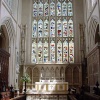thanks for your support, gang. If i' may bore you for a few minutes I'll explain a little about St George if I may.
As the English are a 'little' reserved and tend not to shout too much about their flag or their adopted Patron saint. Unlike our all our neighbouring countries who shout it from the rooftops. I think we should do as well
Firstly the Flag, a red cross on a white background, it forms the center of the British flag, commonly called 'The Union Jack'. the rest of the Union flag is madeup of the white diagonal cross on blue which is the cross of St. Andrew, the patron saint of Scotland. The reason we have the 'Red Cross' is further explained in the following explaination.(Wales and Northern Ireland have their own variation)
Who was St George? What is myth and what is fact? Did he really slay the Dragon? Why is he such a popular Saint, celebrated in so many Countries, Races, Religions and Organisations?
The celebration of St George's Day is currently fairly low key in England and much more celebrated elsewhere. However, the St Georges Society and its members are clearly succeeding in their constant efforts to revive St. George's Day as the day on which to celebrate being English.
There are many legends in many cultures about St. George, but they all have a common theme; he must have been an outstanding character in his lifetime, for his reputation to have survived for almost 1,700 years!
Most authorities on the subject seem to agree that he was born in Cappadocia in what is now Turkey, in about the year 280 AD. It is probable that from his physical description, he was of Darian origin, because of his tall stature and fair hair. He enlisted into the Cavalry of the Roman Army at the age of 17, during the reign of the Emperor Diocletian and very quickly established a reputation amongst his peers, for his virtuous behaviour and physical strength; his military bearing, valour and handsome good looks.
He quickly achieved the rank of Millenary or Tribunus Militum, an officer's rank roughly equivalent to a full Colonel, in charge of a regiment of 1,000 men and became a particular favourite of his Emperor. Diocletian was a skilled military tactician and strict disciplinarian, who set himself the task of rejuvenating the morale of the citizens of Rome by reviving the prevailing traditions and paganism of Rome. It may be recalled that this was a time of high inflation and civil unrest and one outcome of this was the increasing influence of Christianity.
Diocletian's second in Command was Galerius, the conqueror of Persia and an avid supporter of the Pagan religion. As a result of a rumour that the Christians were plotting the death of Galerius, an edict was issued that all Christian Churches were to be destroyed and all scriptures to be burnt. Anyone admitting to being a Christian, would lose his rights as a citizen, if not his life.
As a consequence, Diocletian took strict action against any alternative forms of religion in general and the Christian faith in particular. He achieved the reputation of being perhaps the cruellest persecutor of Christians at that time.
Many Christians feared to be loyal to their God; but, having become a convert to Christianity, St. George acted to limit the excesses of Diocletian's actions against the Christians. He went to the city of Nicomedia where, upon entering, he tore down the notice of the Emperor's edict. St. George gained great respect for his compassion towards Diocletian's victims.
As news spread of his rebellion against the persecutions St. George realised that, as both Diocletian and Galerius were in the city, it would not be long before he was arrested.He prepared for the event by disposing of his property to the poor and he freed his slaves.
When he appeared before Diocietian, it is said that St. George bravely denounced him for his unnecessary cruelty and injustice and that he made an eloquent and courageous speech. He stirred the populace with his powerful and convincing rhetoric against the Imperial Decree to persecute Christians. Diocietian refused to acknowledge or accede to St. George's reasoned, reproachful condemnation of his actions. The Emperor consigned St George to prison with instructions that he be tortured until he denied his faith in Christ.
St George, having defended his faith was beheaded at Nicomedia near Lyddia in Palestine on the 23rd of April in the year 303 AD.
Stories of St. George's courage soon spread and his reputation grew very quickly. He soon became known in Russia and the Ukraine as the Trophy Bearer and his remains are said to have been buried in the church that bears his name in Lydda. However, his head was carried to Rome, where it was preserved in the Church that is also dedicated to him.
St George was beatified by the Roman Catholic Church and is recognised in the liturgy of the Russian Orthodox and Greek Orthodox Churches as well as the Roman Catholic Church. He has been revered in the Ukraine since Christianity was established in 988 AD by Volodymyr the Great the Prince of the Kyivan empire. The Romanesque Monastic order in Prague established St. George's Church in the Castle in the year 920AD and in the year 1119 AD the Cathedral of St George was founded in Novgorod. His reputation for virtue and chivalrous conduct became the spiritual inspiration of the Crusaders and by this time the pennant or flag with a red cross on a white or silver background became prominent as a means of recognition by English Knights. It was also worn on breast plates.
In the year 1348 King Edward Ill established the Knights of the Garter, which is the oldest order of Chivalry in Europe. The Order of the Garter was dedicated to the Blessed Virgin Mary, Edward the Confessor and St George. The Insignia of the order consists of a collar and badge appendant known as the George, the Star, the Garter and the Sash with the Investment Badge called the lesser George. This is a gold and richly enamelled representation of St George on horseback slaying the dragon.
A similar representation of St George can be seen in our Armorial Bearings and in the collar and appendant that officers of The Royal Society wear.
In 1352 the College of St George was established in Windsor, with 6 Chorister boys and since then, St George's school has played an important role in the daily worship and on State Occasions in the Queen's Free Chapel of St George in Windsor Castle. By providing free education and sustenance for the boys, a priceless musical inheritance in choral worship has been established and their numbers increased until the Plague struck in 1479 when the numbers were reduced from thirteen to six again but recovered to thirteen by Michaelmas in 1482.
It was in the year 1415 AD that St. George became the Patron Saint of England when English Soldiers under Henry V won the battle of Agincourt.
In 1497 in the reign of Henry VIII, the pennant of the Cross of St. George was flown by John Cabot when he sailed to Newfoundland and it was also flown by Sir Francis Drake and Sir Walter Raleigh. In 1620 it was the flag that was flown by the Mayflower when the Pilgrim Fathers arrived in Plymouth Massachusetts. It is also the flag of the Church of England and as such is known throughout Christendom.
In the year 1728 AD Maximilian II Emanuel, the Elector of Bavaria, established by Papal Bull The Royal Military Order of St George, as a means of honouring distinguished military service for it was clear that by this time, his name had become associated with the purity of spirit, selfless devotion to duty and boundless courage and valour in the face of adversity. In more recent times, St George was chosen as the patron saint of Scouting, because of the ideals that he represents and it is interesting to note that he is also the Patron Saint of Barcelona in Catalonia, Aragon, Russia, Bavaria, Beirut, Czechoslovakia, Portugal, Lithuania and Hungary, to name but a few. Virtually every country in Europe and the Commonwealth has a church dedicated to St. George.
During World War 2 King George V1 established the George Cross for outstanding acts of Civilian Valour and one of the earliest recipients was the Island of Malta, for its outstanding courage in~ the face of the constant bombardment by the Italian and German Airforce. It is, coincidentally, the Island that was so closely associated and governed by the Crusaders who arrived from the Island of Rhodes in the 14" Century, following their 200 year war with the Turks.
The legends about St George spread far and wide and it was claimed that near the town of Silene in Libya, a dragon dwelt, keeping the population in terror. To satiate him the population tethered an animal, until they had no more. They then provided human sacrifices and in ultimate desperation, a young princess was selected, the king's daughter named Cleolinda. The story then relates how St. George rode up on his white charger, dismounted and fought the monster on foot; until it eventually succumbed. He then dragged the dying monster into the city, using the girdle of the Princess and slew the dragon in front of the people. St. George was greeted as their saviour and the King offered him a bag of gold as a reward for saving his daughter. This he refused and asked that it be given to the poor.
The story is a powerful allegory, emblematic of the triumph of good over evil; but it also teaches of enduring Christian faith in the extreme and the trust that at all times should be placed in the Almighty by the invocation of the name of St. George, Soldier, Saint and Martyr.
In the 13" Century, there was a Guild of St. George to which the Honourable Company of Pikemen were related before evolving into the Honourable Artillery Company. Many regiments of the Army still celebrate St. George's Day with great ceremony.
Thanks for taking the time to read this








